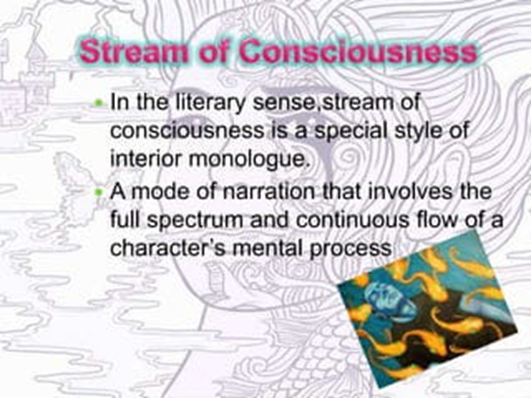Stream of Consciousness in the novel Mrs. Dalloway
What is stream of consciousness?
"Stream of consciousness"
refers to a narrative technique that aims to depict a character's unfiltered
and continuous flow of thoughts, feelings, and perceptions. This technique,
inspired by William James' concept of the ceaseless progression of thoughts in
the mind, captures the inner workings of a character's mind in a raw and
organic manner. It often involves sensory descriptions, fragmented ideas, and
unconventional sentence structures to replicate the way thoughts naturally
occur. This technique emerged during the modernist movement and aims to offer
readers insight into a character's inner world, departing from traditional
narrative styles. It was initially a psychological term that later gained
significance in literary criticism.
What makes stream of consciousness different?
Stream of
consciousness stands apart due to several distinctive features. One key aspect
is its exploration of human relationships through the lens of consciousness.
Authors employ this technique to capture characters' responses to statements,
feelings, attitudes, and reactions to various stimuli. By delving into
characters' thoughts and emotions within specific situations or events, the
stream of consciousness method grants insight into their inner experiences.
Human psychology
plays a crucial role in this approach. The technique delves into characters'
psychology, aiding in the portrayal of their inner workings. An essential
achievement of this technique is fostering human self-understanding. Authors
often use symbols, images, or character reactions to project the divided self,
shedding light on its two facets.
Non-linear
narrative is a hallmark of stream of consciousness. Unusual syntax, grammar,
associative leaps, and repetition characterize this style. The deviations from
conventional grammar and syntax mirror the spontaneous nature of thoughts,
which might be incomplete or interrupted by new ideas. Repetition serves to
emphasize characters' fixation on specific thoughts or sensory impressions,
providing insights into their fascinations and interests.
Plot structure
within stream of consciousness can involve multiple unreliable narrators or a
non-linear timeline. This experimentation with structure aligns with the
modernist era's scientific innovation and research, including Einstein's theory
of relativity. The stream of consciousness technique was harnessed to create a
relative sense of time in novels, reflecting Einstein's notion of time as
relative rather than absolute. This artistic interpretation mirrors the
modernist understanding of time as subjective and existential, varying for each
character.
Stream of consciousness in literary history
The term "stream of
consciousness" originated in the 19th century. In simple words present
memory and past memory clash with each other. And after that further action was
decided it is known as stream of consciousness.
Henri Bergson give the theory of time
full stop according to them; time is divided into two parts. 1.Objective time
and 2. Psychological time
Mrs. Dalloway is the novel that was written
by Virginia Woolf. It is the best example of stream of consciousness.
The term 'stream of consciousness' was
coined out by William James. He is the elder brother of Henry James who was a
novelist and William James was a psychologist, also known as father of
American psychologist. he wrote the famous book - The Principles of Psychology.
In this book, he said about the stream of consciousness. Daniel Oliver (physician)
and Alexander Bain also used the term stream of consciousness in his work.
The "Stream of consciousness" is a narrative device. The technique of 'stream of consciousness' is close to the interior monologue. There are many writers who were interested in psychology and the "psychological novel"
Stream of Consciousness in Mrs. Dalloway by Virginia Woolf
Mrs. Dalloway is
a modernist novel that portrays the complexity of life and focuses on one's
inner experiences and feelings rather than outer actions. The novel uses the
stream of consciousness technique created by William James in his book The Principles
of Psychology (1890). The novel is set in London and includes a one-day event
where Mrs. Dalloway prepares dinner for her guests. The stream of consciousness technique helps
to study human relationships from the level of consciousness. The technique
focuses on the individual self and the inner time of their mind. Individual
emotions and feelings are translated, showing their relationship and
emphasizing their inner thought flow. As Clarissa walks down a London
Street, she meets an old acquaintance, and the novel is floated by a stream of
inner thoughts, or the inner time of the past. She goes back in time when the
reader sees the past relationship between Clarissa and her old friend Sally.
Through Clarissa's inner thoughts, we can trace the complex fabric of the
relationship between the two lovers' pasts, where Woolf presents the sexual
intimacy of Clarissa and Sally. This description also shows great concern with
Woolf's own sexuality. They show complex and visible relationships between friends.
However, another big idea about relationships
is the projection of the inner self and the outer self. This is a direct
influence on psychoanalysis, which was developed during Woolf's time. The idea
of self is an important part of human relationships, and it is beautifully
woven through the flow of information in the novel. In the novel, Peter Walsh,
who before was desperately in love with Clarissa, returned from India to visit
her without informing her and thus surprising Clarissa. When Clarissa questions him
and his time in India, Peter brings up how he fell in love with an Indian, but
it is later apparent that he suppressed his inner insecurities. He told her a
deceptive story to make her jealous, but the person realizes that he is hurt within, but cannot express it externally. Peter's outer self towards Clarissa
is calm, polite and normal, but his inner self is broken, wounded and insecure.
The scene in the novel clearly reflects such human relationships, which with
the help of certain stories pretend to be happy, smile, but the inner self is
the opposite.
References:
Novel: Mrs. Dalloway by Virginia Woolf
litcharts.com/literary-devices-and-terms/stream-of-consciousness
researchguru.net/volume/Volume%2013/Issue%201/RG36.pdf





👌👌👌👍👍🌸🌸
ReplyDelete